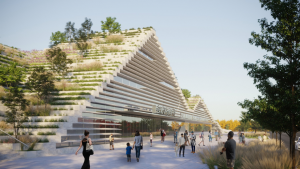Among the things that define Africa’s ‘Golden Horn,’ is the constant onslaught of war the country has had to endure. While the civil war abated, factional in-fighting continued, leaving little hope for stability.
Al-Jazeera describes Somalia’s modern history as “a tale of independence, prosperity and democracy in the 1960s, military dictatorship in the 1970s and 1980s - followed by a desperate decline into civil war and chaos almost ever since.”
The events throughout the country’s history have resulted in the displacement of more than one million Somali refugees. It’s members of this growing diaspora that convened to rediscover the country’s built history. Among the lives moved across borders, and lost altogether, a number of Somalia’s heritage sites and civic structures were also destroyed.
With the aim of restoring this history, and bound by their love for their home country, Somali Architecture was formed by architecture students from the US, UK and Italy. Their mission is to restore the past, while simultaneously leaving traces of what’s happened.
What started as a platform to share images of pre-war Somalia has evolved into a research project that reproduces the buildings digitally in 3D form. This provides some semblance of the Somalia they once knew.
The project seeks to preserve the country’s rich history and the team is confident in their resolve that “it is through understanding history that you can achieve conscious modernity.”
So far they’ve gotten to work on digitally restoring Mogadishu’s National Assembly, National Theatre and Old Parliament buildings, as well as religious institutions like Masaajidk Ishahaysiga (The Mosque and Islamic Solidarity) and the Roman Catholic Church among others.
Now, they've been invited to be the official representatives of Somalia at the London Design Biennale 2018, taking place 4 - 23 September at Somerset House. They're one of just two African countries represented at the event, alongside Egypt. Titled 'What Remains,' the exhibit aims to address the country's architectural history and present, and potential designs for a way forward. Its title certainly alludes to what was left behind after the turmoil the country experienced.
The exhibition is in response to the event's theme this year of 'Emotional States,' which seeks to explore the ways that design influences our emotions.
One of the collective's co-founders, Yusuf Shegow, shared this with us on the inspiration and objectives of the project:
"What remains when the war ends? Ruins preserve histories that are often forgotten. In the face of conflict and destruction, ruins are proof that there was something before the wreckage, before the war, and before the painful emotions, they now evoke. Not all ruins are the same; some buildings remain standing despite attempts to turn them into rubble. They are manifestations of people’s indestructible hope, resilience, and survival."
In order to fund 'What Remains,' Somali Architecture have started a crowdfunding campaign to help make it happen. You can contribute to that here.
To see more of Somali Architecture's work, visit their website here.






